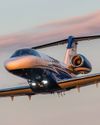
For the past three years in the aviation press, occasional spy photos have appeared, showing an unusual blimplike airplane parked at the former George Air Force Base, now Southern California Logistics Airport, near Victorville, California. This oddity has now made its formal debut. Its name is Celera 500L, and it is a product of Otto Aviation.
Otto makes impressive claims for the Celera, notably that it will cruise at 400 knots at 65,000 feet and have a range of at least 3,900 nautical miles. Powered by a diesel engine and burning jet fuel, it’s said to be eight to 10 times more efficient than comparable jets, to achieve a carlike 25 or so miles per gallon and a 22-to-1 glide ratio.
As I write this, very few specifics about the physical characteristics of the airplane have been published—other than that it accommodates 6 passengers in a spacious cabin with a stand-up center aisle. Its circular fuselage is about 78 inches in diameter and 35 feet long and has the profile of a laminar-flow airfoil section (something similar to a NACA 67-018). The aft-mounted engine drives a multibladed propeller whose diameter seems to be about the same as that of the fuselage. It appears that the elliptical wingspans about 55 feet. If the airplane weighs 7,000 pounds—just a guess—it would require at least 210 square feet of wing area to achieve the FAA-mandated 61-knot stalling speed for single-engine airplanes. That implies an aspect ratio of about 14.
This story is from the December 2020 edition of Flying.
Start your 7-day Magzter GOLD free trial to access thousands of curated premium stories, and 8,500+ magazines and newspapers.
Already a subscriber ? Sign In
This story is from the December 2020 edition of Flying.
Start your 7-day Magzter GOLD free trial to access thousands of curated premium stories, and 8,500+ magazines and newspapers.
Already a subscriber? Sign In

The Temple of Speed
Reno entices even this altitude-oriented pilot.

Flat Sixes
Fanatical artisans

Blue over Green, Tent in Between
I’m old , I’m cranky. Why do I keep air-camping?

Gulfstream Reveals G400, G800
The product lineup gains large-cabin and ultralong-range mounts.

Every Airplane Requires a Checkout
Embrace the challenge of mastering a new machine.

Fuhggedaboutit
Fifty-plus years of f lying forgetfulness

THE MAULE FAMILY APPROACHABLE AIRCRAFT
Choose your mount —the Maules do it all.

Sisters
“ Women certainly have the courage and tenacity required for long flights.” —Mildred Doran

INSIDE OUT OR OUTSIDE IN?
What kind of pilot should you be?

WE FLY: CESSNA CITATION CJ4 GEN2
THE FLAGSHIP CJ JUST GOT A WHOLE LOT BETTER.